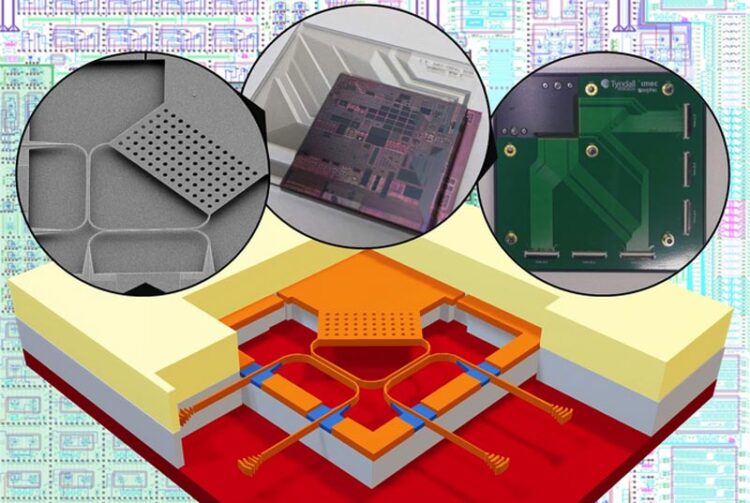Researchers develop silicon photonic MEMS

MEMS technology could enable more efficient fiber-optical telecommunications, datacentres and future quantum computers.
Credit: Professor Niels Quack, University of Sydney
… compatible with semiconductor manufacturing.
Could enable more efficient fiber-optical telecommunications, datacentres and future quantum computers.
A team of researchers led by the University of Sydney’s Associate Professor Niels Quack has developed a new technology to combine optics and micro-electro mechanical systems (MEMS) in a microchip, paving the way for the creation of devices like micro-3D cameras and gas sensors for precision air quality measurement, including their use in mobile phones.
Published today in Nature: Microsystems and NanoEngineering, the new microfabrication process builds on silicon photonics and uses semiconductor manufacturing techniques to enable a new, more energy-efficient generation of devices for fibre-optical communications, sensors and even future quantum computers.
Associate Professor Quack from the School of Aerospace, Mechanical and Mechatronic Engineering said that the photonic MEMS are unique in that they are compact, consume very little power, are fast, support a broad range of optical carrier signals and have low optical loss.
“This is the first time that nano-electro-mechanical actuators have been integrated in a standard silicon photonics technology platform,” Associate Professor Quack said.
“It is an important step towards mature large-scale, reliable photonic circuits with integrated MEMS. This technology is being prepared for high-volume production, with potential applications in 3D imaging for autonomous vehicles or new photonic assisted computing.
“Current similar technologies consume a lot of power and occupy a large area on-chip. They also have high optical losses. This makes the integration of a large number of components on a single chip challenging,” he said.
“Our silicon photonic MEMS technology overcomes these shortcomings, providing a route for efficient scaling of photonic integrated circuits.
“The technology will advance knowledge in the field of micro- and nanofabrication, photonics and semiconductors, with a wide range of applications. These include beam steering for LIDAR 3D sensing in autonomous vehicles, programmable photonic chips, or information processing in quantum photonics.”
DECLARATION
The authors declare no competing interests. This work has been supported by the European Union through the H2020 project MORPHIC under grant 780283. N.Q. acknowledges funding by the Swiss National Science Foundation under grant 183717. The work reported in this manuscript was performed while N.Q. was at EPFL, and the manuscript was in part composed while N.Q. was at the University of Sydney. The authors acknowledge the support of the EPFL Center of MicroNanoTechnology (CMi).
DOI: 10.1038/s41378-023-00498-z
Method of Research: Experimental study
Subject of Research: Not applicable
Article Title: Integrated silicon photonic MEMS
Article Publication Date: 20-Mar-2023
COI Statement: The authors declare no competing interests. This work has been supported by the European Union through the H2020 project MORPHIC under grant 780283. N.Q. acknowledges funding by the Swiss National Science Foundation under grant 183717. The work reported in this manuscript was performed while N.Q. was at EPFL, and the manuscript was in part composed while N.Q. was at the University of Sydney. The authors acknowledge the support of the EPFL Center of MicroNanoTechnology (CMi).
Media Contact
Luisa Low
University of Sydney
luisa.low@sydney.edu.au
Cell: 0438021390
Original Source
All latest news from the category: Information Technology
Here you can find a summary of innovations in the fields of information and data processing and up-to-date developments on IT equipment and hardware.
This area covers topics such as IT services, IT architectures, IT management and telecommunications.
Newest articles

NASA: Mystery of life’s handedness deepens
The mystery of why life uses molecules with specific orientations has deepened with a NASA-funded discovery that RNA — a key molecule thought to have potentially held the instructions for…

What are the effects of historic lithium mining on water quality?
Study reveals low levels of common contaminants but high levels of other elements in waters associated with an abandoned lithium mine. Lithium ore and mining waste from a historic lithium…

Quantum-inspired design boosts efficiency of heat-to-electricity conversion
Rice engineers take unconventional route to improving thermophotovoltaic systems. Researchers at Rice University have found a new way to improve a key element of thermophotovoltaic (TPV) systems, which convert heat…



